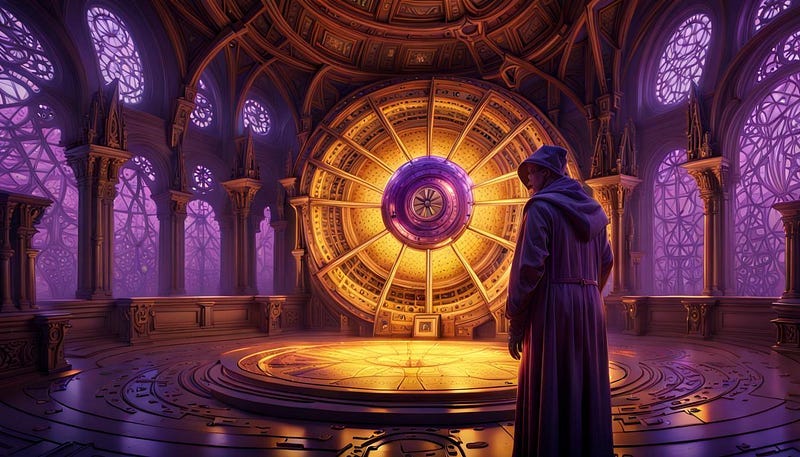Plainly Put
Unravelling the Golden Ratio

Not really, though some philosophers think there is a deep connection somewhere.
In simple terms, there’s a fascinating and kinda magical thing called the Golden Ratio. It’s like a special way of looking at proportions that shows up in all sorts of places, from flowers to paintings.
The Golden Ratio is a special number, about 1.618, and it’s all about how things are put together in a really cool and pleasing way. Imagine it as a sort of secret code that makes things look just right, and today, I’m going to uncover what makes this ratio so interesting and important.
In that strange land of mathematics and aesthetics, few concepts hold the mystique and beauty of the Golden Ratio. Represented by the Greek letter Phi (φ), the Golden Ratio has fascinated mathematicians, artists, and scientists for centuries. This ratio appears in various forms across diverse fields, from the natural world to human-created masterpieces. In this exploration, let’s look into the meaning of the Golden Ratio and its profound implications.
The Golden Ratio Defined — first mathematically, second in plain language
At its core, the Golden Ratio is a mathematical constant that exhibits a unique proportionality — a:b is to b:(a+b) as a whole is to a. In simpler terms, the ratio of the sum of two quantities to the larger quantity is the same as the ratio of the larger quantity to the smaller one. Mathematically, this is expressed as (a+b)/a = a/b = φ.
What the heck does that mean? Try this!
Alright, imagine you have two numbers, let’s call them A and B. Now, here’s a cool trick called the Golden Ratio. If you add A and B together (that’s A + B), and then divide that by the bigger number (A), it’s like magic because it’s the same as dividing the bigger number by the smaller one (B). So, no matter what numbers you start with, this special relationship stays the same.
It’s kind of like having two friends, and if you add their ages and divide by the older one, you get the same result as dividing the older friend’s age by the younger one. It might sound a bit tricky, but it’s a neat pattern that pops up in nature and art. People find it fascinating because it’s like a hidden rule that appears in lots of different places!

Natural manifestations
One of the most enchanting aspects of the Golden Ratio is its prevalence in the natural world. From the spirals of galaxies to the arrangement of petals in a flower, nature seems to adhere to this harmonious proportion. The spirals of a nautilus shell, for example, often follow the Golden Ratio, creating a visually striking and mathematically precise pattern.
The connection between the Golden Ratio and a nautilus shell lies in the mesmerizing spiral pattern of the shell. If you were to carefully measure the proportions of each section of the shell, you might find that they follow the Golden Ratio.
Picture the spiral of a nautilus shell — as it grows, each new section is a bit larger than the one before it, creating a sequence that aligns with the Golden Ratio. The way the shell’s curves expand outward seems to be governed by this special mathematical relationship. It’s like nature is using the Golden Ratio to sculpt this graceful, spiral shape, making the nautilus shell a living example of mathematical beauty in action.
Galaxy spirals, much like the nautilus shell, exhibit a connection to the Golden Ratio through their mesmerizing shapes. When we observe spiral galaxies, such as the famous Whirlpool Galaxy, we see their arms winding out in a beautiful spiral pattern.
In the context of the Golden Ratio, if you were to measure the distances from the center of the galaxy to different points along one of its spiral arms, you might find that these distances correspond to a pattern based on the Golden Ratio. The arms of spiral galaxies often follow a growth pattern that mirrors the proportions dictated by the Golden Ratio, contributing to the elegance and harmony of their celestial appearance.
It’s as if the cosmos itself is using the Golden Ratio to create these breathtaking spirals, hinting at a mathematical order that extends from the smallest patterns on Earth to the vast reaches of our universe. The connection between the Golden Ratio and galaxy spirals adds another layer of awe-inspiring beauty to the already captivating world of astronomy.
The human body, too, exhibits traces of the Golden Ratio. The relative proportions of the human face and body, including the arrangement of facial features and limb lengths, sometimes adhere closely to the Golden Ratio. While not a strict rule, these occurrences suggest a fascinating link between mathematics and the physical world.
The connection between the Golden Ratio and the human body is a bit like finding a hidden harmony in our physical proportions. While it’s not a strict rule, some aspects of the human body seem to reflect the Golden Ratio.
Consider, for example, the way our fingers are arranged. If you measure the lengths of each section of your fingers, from the tip to the first joint, then from the first to the second joint, and so on, you might find that these lengths follow the Golden Ratio. The same can be said for other body parts, like the forearm or the segments of your fingers.
Facial features, too, can sometimes be linked to the Golden Ratio. For instance, the distance between the eyes compared to the width of the nose, or the ratio of the width of the mouth to the distance between the eyes, may approach the Golden Ratio.
It’s important to note that this isn’t a strict rule for every person; there’s incredible diversity in human bodies. Still, the occasional appearance of the Golden Ratio in our physical makeup adds an intriguing layer to the mystery of how beauty and proportion are perceived, both in art and in the mirror.
Artistic applications
Artists throughout history have been drawn to the Golden Ratio as a tool to create visually appealing compositions. Some of the most celebrated works of art, such as Leonardo da Vinci’s “Vitruvian Man” and the Parthenon in Athens, are said to incorporate the Golden Ratio in their designs. The use of this ratio is believed to enhance aesthetic harmony and balance in visual arts and architecture.

Music and the Golden Ratio
Again, the Golden Ratio finds resonance in the world of music. Composers like Mozart and Beethoven are thought to have incorporated the Golden Ratio into the structure of their compositions. The idea is that the ratio can be applied to the timing and arrangement of musical elements, resulting in a harmonious and pleasing auditory experience.
Mozart and Beethoven, two of the greatest composers in history, are believed to have incorporated the Golden Ratio into their musical compositions. This connection adds an extra layer of mathematical intrigue to their already masterful works.
In music, the Golden Ratio might manifest in the timing and structure of a piece. For example, if you take specific sections of a composition and analyze the timing or the duration of musical phrases, you might find that these durations bear a relationship to the Golden Ratio.
It’s as if these musical geniuses were not only crafting beautiful melodies but also embedding a subtle mathematical harmony into the very fabric of their compositions.
This connection to the Golden Ratio isn’t a rigid rule in music, and different pieces will exhibit different mathematical relationships. However, the idea that composers like Mozart and Beethoven may have intuitively incorporated the Golden Ratio into their works adds a fascinating layer to the appreciation of their artistry. It suggests that beyond the emotional depth and creativity, there may be a hidden mathematical structure contributing to the timeless beauty of their music.
Mathematics and Fibonacci Sequence
The Golden Ratio is intimately connected with the Fibonacci sequence, a series of numbers where each number is the sum of the two preceding ones (0, 1, 1, 2, 3, 5, 8, 13, 21, and so on). As you progress through the Fibonacci sequence, the ratio of consecutive numbers approaches the Golden Ratio. This connection deepens the mathematical intrigue surrounding the Golden Ratio and its ubiquitous presence in various mathematical constructs.
Implications and controversies
While the Golden Ratio’s influence is evident in many aspects of the natural and artistic worlds, its role is not without controversy. Sceptics argue that the prevalence of the Golden Ratio in nature and art may be coincidental, and its significance could be overstated. Some suggest that humans are prone to finding patterns where none exist, a phenomenon known as apophenia.
In conclusion, the Golden Ratio, with its rich mathematical properties and widespread occurrences, continues to captivate and inspire across disciplines. From the nautilus shell to the canvases of master artists, the Golden Ratio weaves a common thread through the fabric of our understanding of beauty and proportion.
While its implications may be a subject of debate, there is no denying the allure of this mathematical constant and its enduring impact on our perception of the world.
Livio, Mario. (2003). The Golden Ratio: The Story of Phi, the World’s Most Astonishing Number. Broadway Books.
Huntley, H. E. (1970). The Divine Proportion: A Study in Mathematical Beauty. Dover Publications.
Ghyka, Matila. (1977). The Geometry of Art and Life. Dover Publications.
Markowsky, George. (1992). Misconceptions about the Golden Ratio. The College Mathematics Journal, 23(1), 2–19.




